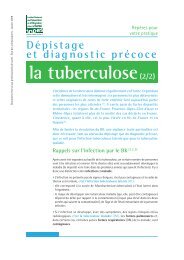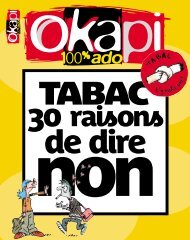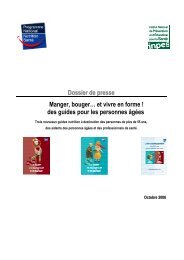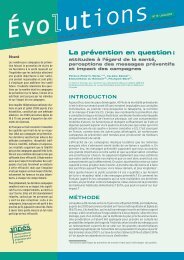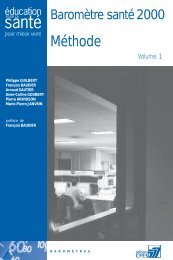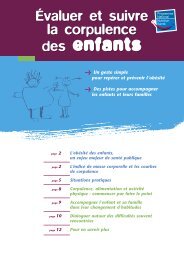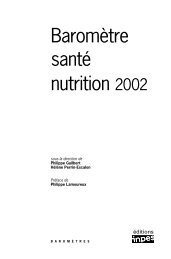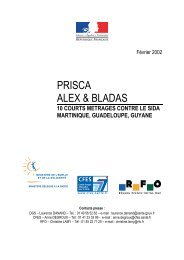Strengthening Families Program - Inpes
Strengthening Families Program - Inpes
Strengthening Families Program - Inpes
- No tags were found...
Create successful ePaper yourself
Turn your PDF publications into a flip-book with our unique Google optimized e-Paper software.
<strong>Strengthening</strong> <strong>Families</strong><strong>Program</strong>
<strong>Strengthening</strong> <strong>Families</strong> <strong>Program</strong>DEVELOPED BYKarol L. Kumpfer, Ph.D.ProfessorDept of Health Promotion and EducationUniversity of Utah1901 East South Campus Drive, Room 2142Salt Lake City, Utah 84112Phone (801) 581-7718
SFP: Important Points• SFP is three skills courses:Parenting, Children’s, & Family Skills.• SFP skills are for all families; they are notspecial skills for deficient families.• SFP does make learning “Life Skills”easier for high-stress families.• SFP: a “family” is one or more adults withlong-term responsibility for one or morechildren; a “parent” has that responsibility.
SFP: Goals and Settings• SFP is therapeutic, but not therapy;personal disclosure is not required• Strong families reduce risk for many adversebehaviors in children & teens• SFP makes family life lessstressful and more rewardingfor parents under stress.• SFP is delivered by schools,faiths, and community agenciesfor voluntary, referred, requiredand mandated families
Family Responsibilities• Accepting responsibility makes a family:– Physical necessities– Emotional support– Learning opportunities– Moral guidance– Building skillsand resilience• When families fail,society pays a tremendous price.
The Critical Roleof <strong>Families</strong>• Effective parenting is the Anti-Drug.• Parenting is the important component in multicomponentprevention programs.• A root cause of substance abuse isdysfunctional family relationships.• Parents teach values and habits, good or bad,by their actions and by their words
Parents as much as peers
SFP Strengthens Major ProtectiveFactors against Drug UseSelf-ControlAcademicSelf-EfficacyFamilyBondingFamilySupervisionFamilyand PeerNormsNoSubstanceUseSocial andCommunityPreventionEnvironmentFemale: (n=5,488)Male: (n=3,023)
SFP Strengthens Major ProtectiveFactors against Drug Use by Gender(Kumpfer, Whiteside, & Turner, 2003)Self-ControlFamilyBondingSocial andCommunityPreventionEnvironmentF = .21M= .27F = .71M= .71F = .62M= .55AcademicSelf-EfficacyFamilySupervisionF = .12M= .17F = .43M= .36F = .19M= .16Familyand PeerNormsNormed Fit IndexF: .90M: .90F = .88M= .88NoSubstanceUseFemale: (n=5,488)Male: (n=3,023)
Research Affirms <strong>Families</strong>• CSAP: the strongest path to preventing ATOD abuse:1. Family Bonding (love and attachment)2. Family Supervision3. Family Norms (communicating positive values)(CSAP, 2002; Kumpfer, et al., 2004)The National LongitudinalAdolescent Health Study found:►Parents are the major reasonkids do not use drugs.►Parents are the primary rolemodels and teachers.(Resnick, et al., 1997)
Protective Factors in Youth 9-17.6Standardized.4.2-.0-.2•Family BondingSelf-controlSchool BondingSelf-EfficacyMean-.4-.691011121314151617Belief in SelfSocial Confidence
Strong <strong>Families</strong>, Strong Children• Strong families avert many adverse outcomes:substance abuse, teen pregnancy, schoolfailure, aggression and delinquency. (Hops, et al., 2001)• Girls are even moreinfluenced by familyprotective and risk factors.• Protective factors strongestbefore 10-11 years of ageand drop during junior highschool, offering a time ofopportunity for children 6-11 years.
Parents’ InfluenceEquals Peers’• National LongitudinalAdolescent Health Survey(Resnick, et al., 1998)• Social Ecology Model (Kumpfer & Turner,1990/1991)• CSAP’s High Risk Youth Pathway Models(CSAP, 1999)• Models for Substance Abuse, Delinquency,Teen Pregnancy, School Failure (Ary, et al.,1999)
Pathways to Risk/ProtectionFamily Environment Risk FactorsBiological Risk FactorsResiliency
Family Life Risk Factors• Family conflict• Lack of love, care & support• Weak, severe or inconsistentdiscipline• Lack of family customs & traditions• Low expectations for school success• Poor family management• Lack of communication• Sexual, physical or emotional abuse
Family Protective Factors• Parent/child attachment• Parental monitoring and discipline• Consistent, predictable parenting• Parents’ communication of values andexpectations about drugs & other riskybehaviors
Biological Risk Factors• Genetically Inherited Risks– Difficult Temperament– Rapid Tempo– Autonomic Hyperactivity– Lower Verbal IQ– Rapid Metabolism of Alcohol– Fetal Alcohol & Drug Syndrome
What is Resiliency?• Why does one child in a family or one familyin a community do well despite adversity?• Resilient youth do well despite family andpersonal problems or set-backs.• Resilient youth learn from failures andbounce-back.• Resilient youth are capable of positivechange after life stress.
Seven Resiliency Characteristics• Caring and Empathetic• Wise and Insightful• Happy and Optimistic• Intelligent and Competent• High Self-esteem• Direction, Mission and Purpose in Life• Determination and Perseverance
SFP Teaches Resiliency Skills• Speaking and Listening• Planning & Organizing (family meetings)• Problem Solving• Peer Resistance• Restoring Self-Esteem• Identifying Feelings, Taking Criticism• Managing Feelings, Coping with Anger
SFP Stresses:• Importance of one caring adult• Opportunities to help others• Social skills for home & away• Self-discipline• Communication of family expectations,including drugs & alcohol• Parents’ help with critical life decisions
SFP in Practice
SFP Development and History1 st research-based family program for substanceabusing parents and their children1982-1984 Developed on NIDA grant forelementary school-aged children, ages 6-111994 Adapted for universal families with childrenages 10-142004 Adapted for at-risk families with childrenages 12-162006 Adapted for at-risk families with childrenages 3-5Proven effective with universal and at-risk families
SFP Cultural Adaptations• African-American, rural and urban• Spanish language translation• Pacific Islander version• Canadian version• Australian version• American Indian versions• Swedish, English, Dutch, Spanish versionsSimilar results for culturally adapted versions,but 40% better recruitment and retention
SFP in Practice• SFP: 3 Life Skills Courses:Parents, Children’s & Family Skills• All three are taught together,typically over 14 weeks.• Courses can be “unbundled,”but are most effective whentaught together.
SFP Typical Class SessionFAMILY STYLEMEAL1 Hour Simultaneously+1 HourCHILDGROUPPARENTGROUPFAMILYGROUP(S)
A Typical Weekly Session• Dinner - families sit together, with otherfamilies & Group Leaders• 1st Class Hour: Parents’ Group andChildren’s Group• 2nd Class Hour: families rejoin & divideinto two Family Groups• Baby-sitting: for children under 6;(ideally, activities for children 11+)
Staffing• Top Qualifications for Leaders:– sincere desire to help families learn SFP– personal skills: one-to-one & group– understanding why and how SFP works• 4 Group Leaders: 2 for Parent Group,2 for Children’s Group• Group Leaders: mix salaried and hourlycontracted staff to balance teams to include men& women, ethnicities.
Site: Safe, Welcoming,Accessible• 3 rooms minimum:– 1 large room for meals, baby-sitting– 2 smaller rooms for Parent’s & Children’s groups andthen Family groups• Agency site or community partner: faithcommunity, housing authority• Size: Ideally for 6-12 families.But how big are your rooms?How big are your families?How challenging are your families?How skilled are your leaders?
“Extras” - that aren’t• Meals: remove an obstacle and providean incentive to attend• Transportation: know what you can doto get families there• Baby-sitting: for children under 6,activities for children over 11 years• Small rewards for attending, homepractice, progress• A BIG graduation & party
Site Coordinator: A Key Role• Course arrangements:– Books, class materials, open-up, set-up– Meals– Transportation– Baby-sitting• Communication: with families, Leaders• Recruitment: coordinates recruitment• Supports, Supervises Group Leaders
Sample SFP Budget -10families• Site Coordinator: (14 weeks x $30/hr x 10hrs/week) $4,200• Group Leaders: (4 x 14 weeks x $20/hr x 5 hrs/week) 5,600• Food: (14 sessions x 10 families x $10/family) 1,400• Child Care: (14 wks x 2 staff x $15/hr x 3 hrs) 1,260• Supplies: (paper products, toys) 440• Completion Incentives: ($50 x 10 families) 500• Handbook Duplication: (15 parents + 20 children x $8) 280• Manual Duplication: (4 trainers x $30/set – one time) 120Total $13,800Reunion Session:Group Leaders (4x$20/hr. x 4 hours) $ 320Site Coordinator ($30/hr. x 10 hours) 300Food (10 families x $10/family) 100Child Care (2 staff x $15/hr. x 3 hours) 90Incentives, supplies 190$1,000
SFP: Outcomes
<strong>Strengthening</strong> <strong>Families</strong> <strong>Program</strong>• NIDA (1982-1986) research and 15 SFPreplications found positive results:•Improved parenting knowledge & skills•Improved family relationships•Improved children’s social skills andbehavior
SFP Component Outcomes• Parent Training: increases parenting skills and decreaseschildren’s conduct disorders and decreased family conflict• Children’s Skills Training: Increased children’s socialskills• Family Skills Training: Increased family cohesion andorganization; reduced parent & child alcohol/drug use
SFP Results: Parent• Increased parenting efficacy• Increased parenting skills• Increased marital communication• Decreased stress• Decreased depression• Decreased alcohol and drug use
SFP Results: Child• Decreased depression• Decreased conduct disorders• Decreased aggression• Decreased tobacco, alcohol, drug use• Increased cooperation• Increased number of pro-social friends• Increased social competencies• Increased school grades
SFP 5-Year Follow-up Results97% More quality spent time with child95% More appropriate consequences94% Increased enjoyment of the child84% Better problem solving with child75% Reduced family stress & conflict68% Holding family meetings monthly37% Holding a family meeting weekly
Effect Sizes for Child-Only Prevention(Tobler, 1999)• School-based Affective - .05• Knowledge + Affective .05• Health Education .18• Life or Social Skills Training .28• Average: Child-only .10
Effect Sizes for Family-basedPrevention (Tobler & Kumpfer, 2000)• Parenting Skills Training .31• Family Therapy .45• Family Skills Training .82• In-home Family Support 1.62• Mean ES Family Interventions .96
SFP: An Evidence-based Practice• NIDA Red Book• OJJDP <strong>Strengthening</strong> America’s<strong>Families</strong>• CSAP Model <strong>Program</strong>• CMHS Model <strong>Program</strong>• ONDCP Model <strong>Program</strong>• International Cochrane Collaboration(Foxcroft, et al, 2003)
SFP Course Materials• 3 Group Leader Manuals: Parent’s,Children’s & Family Groups -complete lessons for all classes• 2 Handbooks or Handouts: Parent’sChildren’s – worksheets, lessons• 1 Implementation Manual:outcome, process & fidelity checks(Handbooks are included, chapter bychapter, in Group Leader Manuals)
SFP6-11 and SFP12-16Parent Group Leader (GL) Manuals ComparedWhy compare only 6-11 & 12-16 GLmanuals?• SFP3-5 overall tracks SFP6-11 overall exactly.• SFP12-16 Teen GL Manual tracks Parentexactly.• So comparing SFP6-11 Parent GL Manuals andSFP12-16 Parent GL Manuals best compares allthree age variants – SFP3-5, SFP6-11 & SFP12-16.
SFP6-11 and SFP12-16Parent Group Leader (GL) Manuals Compared1. Intro & Group Building 1. Intro & Group Building2. What Kids/Teens Can Do & Managing Stress3. Rewards 3. Get Good Behavior4. Goals & Objectives 4. Goals & Objectives5. Noticing & Ignoring 5. Communication I6. Communication I 6. Communication II7. Communication II 7. Help Handle Pressure
SFP6-11 and SFP12-16Parent Group Leader (GL) Manuals Compared8. Alcohol Drugs <strong>Families</strong> 8. Alcohol Drugs<strong>Families</strong>9. Problems & Directions 9. Problems & Directions10. Setting Limits I 10. RelationshipsSexuality11. Setting Limits II 11. Setting Limits I12. Setting Limits III 12. Setting Limits II13. Behavior <strong>Program</strong>s 13. Contracts forBehavior14. Keep Good Behavior 14. Keep Good Behavior
• SFP12-16 adds:SFP6-11 and SFP12-16Differences Summarized• SFP6-11 has Sessions 3, 4 & 5 on“positives;• SFP12-16 has Sessions 3 & 4 on“positives.”• SFP6-11 has Sessions 10, 11 & 12 onlimits.• SFP12-16 has Sessions 11 & 12 on limits.
SFP6-11 and SFP12-16Differences Detailed• 6-11 Child’s Game becomes 12-16 OurTime• 6-11 Parent’s Game is not used in 12-16;in- group practice of clear directionsinstead.• 12-16 adds Helping Teen HandlePressure,
Family Training:Child’s Game• What: special time for each child with parent• Objective: to increase positive parent/child relationship• For a younger child: parent sets ground rules:(stay here, don’t throw, don’t break, etc);then: “play as you like with what’s on table.”• Parent’s Job: Just notice and describe:What child is doingFeelings on child’s faceParent comments like sportscaster on child’s actionsShows child parent is paying attentionHelps parent just watch; helps child learn feelings• For an older child: like adult interest in a friend
Child’s Game: How?• Parent should not: direct,correct, instruct, criticize• Parent may play if asked.• Parent may say: “This willhelp me be a better parent.”• With an older child: joinchild who is already doingsomething; may want to ask“Is this a good time?”
Why Child’s Game?• Strengthens parent-child bond before attemptingnew approaches to discipline/guidance• Builds parent’s ability to pay attention to child(turning attention away will be used later.)• Reminds child how good parent’s attention feels.• Used in Parent/Child Interactive Therapy (Eyberg)to reduce reactive attachment disorders andbond to parent or caregiver.
Parent’s Game• A way to learn and practice clear,consistent directions in class.• Practice for the parent in giving cleardirections.• Practice for the child in followingdirections.• Practice for parent in rewardingcompliant child or giving• Appropriate consequences for noncompliance.
When in Family Sessions?• Younger Child: begin after Child’s Game:Will make sense to child as “turn-about.”• First: Putting away Child’s Game toys.• Then: teaching some new activity or craft.• Older Child: teaching a new activity or craft.• For any age: might include cultural arts, songs,music, in preparation for graduation.
Parent’s Game:Tips on Giving Clear Directions• One thing at a time: (not this, then this, and then this)• Be specific: “Please make your bed and hang up yourclothes,” not “Clean up your room.”• Don’t ask: Say, “Xavier, please make your bed,” not“Would you like to make your bed?”• Don’t say “Let’s.....” unless you mean “Let’s do thistogether.”• Don’t follow a direction with a long explanation:A short explanation before is better:“Company’s coming; please hang up your coat.”
Importance of Consistency• Reward with thanks if a child complies, with or withouta warning: “Thanks, son, great job.”• Give a warning if a young child does not complypromptly or an older child by the time you have set.Rephrase the direction consistently as a warning:“Tanya, you need to hang up your coat now.”• Give a consequence right away, every time If childdoes not comply after warning. This is not always easyto do.
The Importance of Consistency• Teaching Coercion Saying “No”to a child, then weakening underpressure, teaches the wronglesson: “coercion will get what youwant.”• Children are quick learners,whether you intend it or not.• Consistency is a goal:no one is perfect – but try.
Family Meetings• Family Meetings: a time to share goodfeelings, plan for family activities, solve familyproblems, reward behavior.• When: best weekly, often Sunday or Mondayevening.• Why: a powerful tool for making the most offamily resources and opportunities, avoidingproblems, building sense of family membership& tradition.
Family Meetings: One Model• Open with round of compliments• Schedule week’s activities• Family business(speaker, listener, coach for conflicts)• Chore Charts - check and reward• End with a treat - often dessert
Family Meetings: Tips• Write down agreements.• Keep it short, worthwhile for wholefamily.• Make it Work: Make it your familymeeting, the way your family does things.Call it what you like, hold it when you like,one person always runs the meeting ortake turns.• Make it a Tradition:Kids love to know “how we do it.”
Sample 20 Minute LessonMinutes:Lesson1 Welcome3 Home Practice - Review5 Explain Topic & Objectives of Lesson9 Group Exercise2 Assign Home Practice & Goodbye20Debrief Practice Lesson:10 Trainers ask “Leaders,” “Group,” and then class:How did it go? What worked or didn’t?30 Minutes
Practice Lessons: Tips• Give the feeling of a real lesson – always be in-character.• Be selective - you may omit parts of lesson or skip people.• Decide ahead who will handle which parts of the lesson.• Come prepared with materials you would bring to a class.• Stay engaged: The Group Leader not speaking isresponsible for the group.• Assume a site coordinator is available outside the room.• Present from a posted outline, not from book or notes.
How to Contact Us<strong>Strengthening</strong> <strong>Families</strong> <strong>Program</strong>karol.kumpfer@health.utah.eduwww.strengtheningfamiliesprogram.orgwww.strengtheningfamilies.org(34 Best Practices Parenting <strong>Program</strong>s)LutraGrouphwhiteside@lutragroup.com
Thank You
Recruitment and Retention:• Respect & Satisfied Guests– The keys to word-of-mouth referrals• Recruitment: A Continuing Effort– Involves all agency staff & group leaders– Led by Site Coordinator• Think of Participants as your Guests:– Provide for their comfort & convenience– Make coming to class easy and appealing
Make SFP Attractive,Accessible• Meals – a draw and a barrier removed• Transportation help - vouchers, bus tokens/schedules, phone trees, vans• Child Care - for younger kids & older• Rewards for attendance, participation• Weekly Calls - “check-in” from Leaders• BIG Graduation: ceremony, party
Marketing to ProspectiveStudents• Invite grads to 1st dinner of next class• Let parents invite guests to Lesson 9• Let parents invite guests to graduation• Hold booster “reunions” at intervals for eachclass or monthly “open” reunions• Offer graduates rewards for recruiting
Adaptation and Modification• Adaptations are changes made to get families to theobjectives of a lesson - ways to make SFP work betterfor these families.• Adaptation includes making SFP a better fit in terms ofculture, age, local custom, religion, or gender.• Research shows that adaptations didn’t improveoutcomes, but improved recruitment and retention by40% Kumpfer, Alvarado, Smith, & Bellamy, 2002).• Adaptations can be made in advance by culturalconsultants, program developers, group leaders andparents; or made on the spot in response to groupreactions to the lesson.
Adaptation of SFPis Essential• Skillful adaptation is essential to the success of theprogram. It makes lessons come alive.• Modifications involves fundamental changes; i.e.,dropping, adding or rearranging lessons. Effects areunknown until evaluated.• Adaptation can make course concepts more readilyunderstandable or acceptable.• Adaptation can mean more familiar wording examples,explanations or exercises.• Use creativity and imagination to make SFP appealingand understandable to the group: humor, examples, roleplay, props.• The developer encourages you to adapt!



